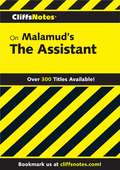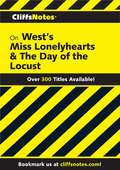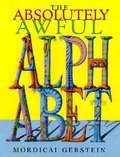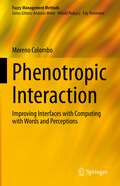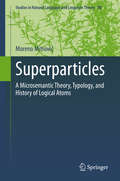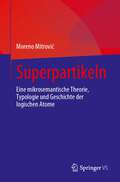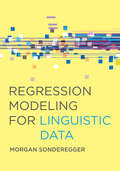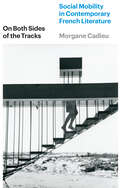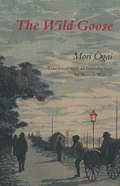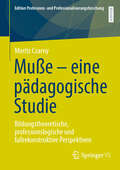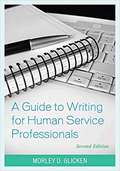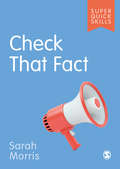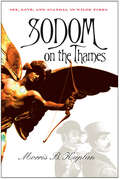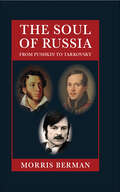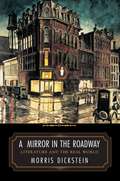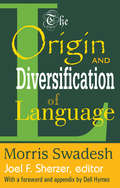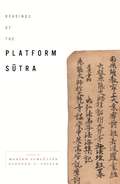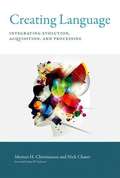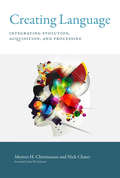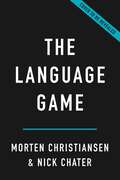- Table View
- List View
CliffsNotes on Malamud's The Assistant
by Mordecai MarcusThis CliffsNotes guide includes everything you've come to expect from the trusted experts at CliffsNotes, including analysis of the most widely read literary works.
CliffsNotes on West’s Miss Lonelyhearts & The Day of the Locust
by Mordecai MarcusThe original CliffsNotes study guides offer expert commentary on major themes, plots, characters, literary devices, and historical background OCo all to help you gain greater insight into great works you're bound to study for school or pleasure. "CliffsNotes on West's Miss Lonelyhearts & The Day of the Locust" offers a close look at the painstaking craftsmanship of Nathanael West's two best novels, which provide material for engrossing entertainment and serious thought. Each of these books demonstrates West's incisive psychological and social probing into how society can crush or leave empty all who live in it. In this study guide, you'll find Life and Background of the Author, Introductions to the Novels, Lists of Characters, and more: Critical CommentariesCharacter AnalysesCritical EssaysEssay Topics and Review QuestionsSelected BibliographyClassic literature or modern-day treasure OCo you'll understand it all with expert information and insight from CliffsNotes study guides. "
The Absolutely Awful Alphabet
by Mordicai GersteinThe alphabet never looked like this before--these letters have drippy noses, scratchy hair, and green teeth. They chase each other and pinch each other, and stick out their tongues. Zany art gives each letter a spectacular new personality, and the humorous, alliterative text is sure to stretch young readers vocabularies. Readers young and old will never forget these twenty-six letters . . . and will never look at the alphabet the same way again.
Phenotropic Interaction: Improving Interfaces with Computing with Words and Perceptions (Fuzzy Management Methods)
by Moreno ColomboSuccessful interaction between humans and artificial systems allows for combining the advantages of all actors in solving problems. However, interaction is often demanding for people, as it builds on artificial concepts, such as strict protocols.This book presents the new paradigm of 'phenotropic' interaction, which aims to improve the naturalness of the interaction thanks to bio-inspired approaches. These include methods for understanding and reasoning with human perceptions expressed as natural language, fundamental to support the artificial system to better understand people's real desires and needs. Methods for improving the theories of computing with words and perceptions are developed in this book and applied to concrete use cases in prototypes enhancing the exchange of information with virtual assistants and smart city ecosystems. The presented use cases serve not only as examples of the application of the phenotropic interaction principles but also to verify their effective impact on communication.
Superparticles: A Microsemantic Theory, Typology, and History of Logical Atoms (Studies in Natural Language and Linguistic Theory #98)
by Moreno MitrovićThis book is all about the captivating ability that the human language has to express intricately logical (mathematical) meanings using tiny (microsemantic) morphemes as utilities. Languages mark meanings with identical inferences using identical particles and these particles thus creep up in a wide array of expressions. Because of their multi-tasking capacity to express seemingly disparate meanings, they are dubbed Superparticles. These particles are perfect windows into the interlock of several grammatical modules and the nature of the interaction of these modules through time. With a firm footing in the module where grammatical bones are built and assembled (narrow morpho-syntax), superparticles acquire varied interpretation (in the conceptual-intentional module – semantics) depending on the structure they fea- ture in. What is more, some of the interpretations these particles trigger are inferential and belong, under the standard account, to the realm of pragmatics. How can such tiny particles, rarely exceeding a syllable of sound, have such powerful and over-arching effects across the inter-modular grammatical space? This is the Platonic background against which this book is set.
Superpartikeln: Eine mikrosemantische Theorie, Typologie und Geschichte der logischen Atome
by Moreno MitrovićIn diesem Buch geht es um die faszinierende Fähigkeit der menschlichen Sprache, mit Hilfe winziger (mikrosemantischer) Morpheme als Hilfsmittel komplizierte logische (mathematische) Bedeutungen auszudrücken. Sprachen markieren Bedeutungen mit identischen Schlussfolgerungen, indem sie identische Partikel verwenden, und diese Partikel schleichen sich so in eine Vielzahl von Ausdrücken ein. Aufgrund ihrer Multitasking-Fähigkeit, scheinbar disparate Bedeutungen auszudrücken, werden sie als Superpartikel bezeichnet. Diese Partikel sind perfekte Fenster in die Verzahnung mehrerer grammatischer Module und die Art der Interaktion dieser Module im Laufe der Zeit. Fest verankert in dem Modul, in dem die grammatischen Knochen gebaut und zusammengesetzt werden (enge Morphosyntax), erhalten Superpartikel je nach der Struktur, in der sie vorkommen, unterschiedliche Interpretationen (im begrifflich-intentionalen Modul - Semantik). Darüber hinaus sind einige der Interpretationen, die diese Partikel auslösen, inferentiell und gehören nach der Standardrechnung in den Bereich der Pragmatik. Wie können so winzige Partikel, die selten länger als eine Silbe sind, so mächtige und übergreifende Wirkungen im intermodularen grammatischen Raum haben? Dies ist der platonische Hintergrund, vor dem dieses Buch steht.
Visual Storytelling: How To Speak To The Audience Without Saying A Word
by Morgan SandlerVisual Storytelling covers all major components of creating powerful images including lighting, camera functions, composition and storytelling. However, the main focus of the book is not just creating compelling visuals, but more importantly creating images that inform and move the audience. Images carry emotional weight and Visual Storytelling teaches readers how to harness these emotions to maximize the emotion of the story, while minimizing the amount of dialogue necessary. What makes Visual Storytelling unique is that it not only covers the theoretical concepts of filmmaking but also the technical elements necessary to achieve the emotional outcome. This combination of theory and practice helps to create well informed and skilled filmmakers.
Regression Modeling for Linguistic Data
by Morgan SondereggerThe first comprehensive textbook on regression modeling for linguistic data offers an incisive conceptual overview along with worked examples that teach practical skills for realistic data analysis.In the first comprehensive textbook on regression modeling for linguistic data in a frequentist framework, Morgan Sonderegger provides graduate students and researchers with an incisive conceptual overview along with worked examples that teach practical skills for realistic data analysis. The book features extensive treatment of mixed-effects regression models, the most widely used statistical method for analyzing linguistic data. Sonderegger begins with preliminaries to regression modeling: assumptions, inferential statistics, hypothesis testing, power, and other errors. He then covers regression models for non-clustered data: linear regression, model selection and validation, logistic regression, and applied topics such as contrast coding and nonlinear effects. The last three chapters discuss regression models for clustered data: linear and logistic mixed-effects models as well as model predictions, convergence, and model selection. The book&’s focused scope and practical emphasis will equip readers to implement these methods and understand how they are used in current work.The only advanced discussion of modeling for linguistsUses R throughout, in practical examples using real datasetsExtensive treatment of mixed-effects regression modelsContains detailed, clear guidance on reporting modelsEqual emphasis on observational data and data from controlled experimentsSuitable for graduate students and researchers with computational interests across linguistics and cognitive science
On Both Sides of the Tracks: Social Mobility in Contemporary French Literature
by Morgane CadieuAn analysis of social mobility in contemporary French literature that offers a new perspective on figures who move between social classes. Social climbers have often been the core characters of novels. Their position between traditional tiers in society makes them touchstones for any political and literary moment, including our own. Morgane Cadieu’s study looks at a certain kind of social climber in contemporary French literature whom she calls the parvenant. Taken from the French term parvenu, which refers to one who is newly arrived, a parvenant is a character who shuttles between social groups. A parvenant may become part of a new social class but devises literary ways to come back, constantly undoing any fixed idea of social affiliation. Focusing on recent French novels and autobiographies, On Both Sides of the Tracks speaks powerfully to issues of emancipation and class. Cadieu offers a fresh critical look at tales of social mobility in the work of Annie Ernaux, Kaoutar Harchi, Michel Houellebecq, Édouard Louis, and Marie NDiaye, among others, shedding fascinating light on upward mobility today as a formal, literary problem.
The Wild Goose (Michigan Monograph Series in Japanese Studies #14)
by Ogai Mori Mori OgaiMori Ogai (1862–1922), one of the giants of modern Japanese literature, wrote The Wild Goose at the turn of the century. Set in the early 1880s, it was, for contemporary readers, a nostalgic return to a time when the nation was embarking on an era of dramatic change. Ogai’s narrator is a middle-aged man reminiscing about an unconsummated affair, dating to his student days, between his classmate and a young woman kept by a moneylender. At a time when writers tended to depict modern, alienated male intellectuals, the characters of The Wild Goose are diverse, including not only students preparing for a privileged intellectual life and members of the plebeian classes who provide services to them, but also a pair of highly developed female characters. The author’s sympathetic and penetrating portrayal of the dilemmas and frustrations faced by women in this early period of Japan’s modernization makes the story of particular interest to readers today. Ogai was not only a prolific and popular writer, but also a protean figure in early modern Japan: critic, translator, physician, military officer, and eventually Japan’s Surgeon General. His rigorous and broad education included the Chinese classics as well as Dutch and German; he gained admittance to the Medical School of Tokyo Imperial University at the age of only fifteen. Once established as a military physician, he was sent to Germany for four years to study aspects of European medicine still unfamiliar to the Japanese. Upon his return, he produced his first works of fiction and translations of English and European literature. Ogai’s writing is extolled for its unparalleled style and psychological insight, nowhere better demonstrated than in The Wild Goose.
Muße – eine pädagogische Studie: Bildungstheoretische, professionslogische und fallrekonstruktive Perspektiven (Edition Professions- und Professionalisierungsforschung #18)
by Moritz CzarnyIn Zeiten rastloser Betriebsamkeit dürfte das Verhältnis von Muße und Bildung zu den vielzitierten ‚vergessenen Zusammenhängen&‘ (Mollenhauer) gehören. Die vorliegende erziehungswissenschaftliche Studie regt dazu an, die Bedeutung der Muße für die Pädagogik unter professionstheoretischen Gesichtspunkten neu zu betrachten. Im Anschluss an die pädagogische Ideengeschichte und an das Modell der ‚Krise durch Muße&‘ in der strukturtheoretischen Professionstheorie zeigen objektiv-hermeneutische Fallstudien Perspektiven für die Habitusbildung und das professionelle Handeln in pädagogischen Arbeitsbündnissen auf.
That Summer in Paris: Memories of Tangled Friendships with Hemingway, Fitzgerald, and Some Others
by Morley Callaghan"That Summer In Paris" brings to the fore the fabulous summer of 1929 when the literary capital of North America moved to La Rive Gauche--the Left Bank of the Seine River--in Paris. Ernest Hemingway was reading proofs of "A Farewell to Arms", and a few blocks away F. Scott Fitzgerald was struggling with "Tender Is the Night". As his first published book rose to fame in New York, Morley Callaghan arrived in Paris to share the felicities of literary life, not just with his two friends, Hemingway and Fitzgerald, but also with fellow writers James Joyce, Ford Madox Ford, and Robert McAlmon. Amidst these tangled relations, some friendships flourished while others failed.
A Guide To Writing For Human Service Professionals
by Morley D. GlickenStraightforward and concise, the second edition of A Guide to Writing for Human Service Professionals offers students and professionals practical tools to improve their writing. In his animated and highly accessible teaching voice, Glicken presents the rules of punctuation, grammar, and APA style in jargon-free language that’s easy to understand. Chapters include detailed, real-world examples on how to write academic papers, client assessments and evaluations, business letters, research proposals and reports, papers for mass audiences, requests for funding, and much more. Glicken provides the most comprehensive writing guide available in an engaging and digestible format, including end-of-chapter exercises that allow readers to further practice their writing and critical thinking skills. A Guide to Writing for Human Service Professionals is an invaluable resource for current and future human service professionals across social work, psychology, and counseling.
Check That Fact (Super Quick Skills)
by MorrisKnowing how to check and challenge information is essential for academic study – and our everyday lives. This practical guide shows you how to be savvy about using sources and improve your information literacy. Learn techniques for efficient and effective fact-checking Find out how to evaluate whether a source is credible Identify and challenge misinformation in academia and beyond. Super Quick Skills provide the essential building blocks you need to succeed at university - fast. Packed with practical, positive advice on core academic and life skills, you’ll discover focused tips and strategies to use straight away. Whether it’s writing great essays, understanding referencing or managing your wellbeing, find out how to build good habits and progress your skills throughout your studies. Learn core skills quickly Apply right away and see results Succeed in your studies and life. Super Quick Skills give you the foundations you need to confidently navigate the ups and downs of university life.
Check That Fact (Super Quick Skills)
by MorrisKnowing how to check and challenge information is essential for academic study – and our everyday lives. This practical guide shows you how to be savvy about using sources and improve your information literacy. Learn techniques for efficient and effective fact-checking Find out how to evaluate whether a source is credible Identify and challenge misinformation in academia and beyond. Super Quick Skills provide the essential building blocks you need to succeed at university - fast. Packed with practical, positive advice on core academic and life skills, you’ll discover focused tips and strategies to use straight away. Whether it’s writing great essays, understanding referencing or managing your wellbeing, find out how to build good habits and progress your skills throughout your studies. Learn core skills quickly Apply right away and see results Succeed in your studies and life. Super Quick Skills give you the foundations you need to confidently navigate the ups and downs of university life.
Sodom on the Thames
by Morris B. KaplanSodom on the Thames looks closely at three episodes involving sex between men in late-nineteenth-century England. Morris Kaplan draws on extensive research into court records, contemporary newspaper accounts, personal correspondence and diaries, even a pornographic novel. He focuses on two notorious scandals and one quieter incident. In 1871, transvestites "Stella" (Ernest Boulton) and "Fanny" (Frederick Park), who had paraded around London's West End followed by enthusiastic admirers, were tried for conspiracy to commit sodomy. In 1889–1890, the "Cleveland Street affair" revealed that telegraph delivery boys had been moonlighting as prostitutes for prominent gentlemen, one of whom fled abroad. In 1871, Eton schoolmaster William Johnson resigned in disgrace, generating shockwaves among the young men in his circle whose romantic attachments lasted throughout their lives. Kaplan shows how profoundly these scandals influenced the trials of Oscar Wilde in 1895 and contributed to growing anxiety about male friendships. Sodom on the Thames reconstructs these incidents in rich detail and gives a voice to the diverse people involved. It deepens our understanding of late Victorian attitudes toward urban culture, masculinity, and male homoeroticism. Kaplan also explores the implications of such historical narratives for the contemporary politics of sexuality.
The Soul of Russia: From Pushkin to Tarkovsky
by Morris Berman"Ecstasy, witchcraft, bewilderment-these ten loving vignettes on scandalous corners of Russian culture, by one of our most seasoned cultural critics, are a tribute to imperishable art even in our catastrophic time." -Caryl Emerson, Professor Emerita of Slavic Languages and Literatures, Princeton University In terms of literature, music, and film, it would be hard to outdo the sheer genius and creativity of Russia. These things constitute the soul of the nation, and it is this that Morris Berman explores in his latest work, The Soul of Russia. His central argument is that at the heart of this brilliance lies a particular idiosyncratic theme: the peasant-shamanic-folkloric tradition of the Russian people, which these artists, from Pushkin to Tarkovsky, drew upon for their inspiration. It was a "Dionysian" source, a nonrational one, and it endowed Russian creative work with what we would have to call vibrancy. Berman presents ten Russian artists who have left their indelible imprint on our collective consciousness. Pushkin offers a supernatural puzzle that Russian scholars are still trying to solve to this day. Gogol tells a tale of a man who wakes up to discover he has lost his nose, and goes in search of it-while his nose has simultaneously taken on a life of its own. Andrei Bely, in Petersburg, explains the revolution of 1905 not through traditional sociological or historical analysis, but by means of a surreal panorama of Oedipal events. Chekhov wittily explores the erotic properties of food, while Diaghilev shocks Europe with the great Vaslav Nijinsky and the Ballets Russes. Composing for this radical dance company, Stravinsky manages to alter the face of music forever. Mikhail Bulgakov offers one of the greatest novels of the twentieth century, The Master and Margarita, and Tarkovsky responds to Stanley Kubrick's famous 2001: A Space Odyssey by coming up with Solaris, a film based not on superficial American techno-fetishism but on questions of love, reality, and human identity. The Soul of Russia is a feast for the mind, but also for the senses-a book that readers will want to delve into more than once.
A Mirror in the Roadway: Literature and the Real World
by Morris DicksteinIn a famous passage in The Red and the Black, the French writer Stendhal described the novel as a mirror being carried along a roadway. In the twentieth century this was derided as a naïve notion of realism. Instead, modern writers experimented with creative forms of invention and dislocation. Deconstructive theorists went even further, questioning whether literature had any real reference to a world outside its own language, while traditional historians challenged whether novels gave a trustworthy representation of history and society.In this book, Morris Dickstein reinterprets Stendhal's metaphor and tracks the different worlds of a wide array of twentieth-century writers, from realists like Theodore Dreiser, Sinclair Lewis, Edith Wharton, and Willa Cather, through modernists like Franz Kafka and Samuel Beckett, to wildly inventive postwar writers like Saul Bellow, Günter Grass, Mary McCarthy, George Orwell, Philip Roth, and Gabriel García Márquez. Dickstein argues that fiction will always yield rich insight into its subject, and that literature can also be a form of historical understanding. Writers refract the world through their forms and sensibilities. He shows how the work of these writers recaptures--yet also transforms--the life around them, the world inside them, and the universe of language and feeling they share with their readers.Through lively and incisive essays directed to general readers as well as students of literature, Dickstein redefines the literary landscape--a landscape in which reading has for decades been devalued by society and distorted by theory. Having begun with a reconsideration of realism, the book concludes with several essays probing the strengths and limitations of a historical approach to literature and criticism.
The Cambridge Companion to William Blake
by Morris EavesPoet, painter, and engraver William Blake died in 1827 in obscure poverty with few admirers. The attention paid today to his remarkable poems, prints, and paintings would have astonished his contemporaries. Admired for his defiant, uncompromising creativity, he has become one of the most anthologized and studied writers in English and one of the most studied and collected British artists. His urge to cast words and images into masterpieces of revelation has left us with complex, forceful, extravagant, some times bizarre works of written and visual art that rank among the greatest challenges to plain understanding ever created. This Companion aims to provide guidance to Blake's work in fresh and readable introductions: biographical, literary, art historical, political, religious, and bibliographical. Together with a chronology, guides to further reading, and glossary of terms, they identify the key points of departure into Blake's multifarious world and work.
The Origin and Diversification of Language
by Morris SwadeshMorris Swadesh, one of this century's foremost scientific investigators of language, dedicated much of his life to the study of the origin and evolution of language. This volume, left nearly completed at his death and edited posthumously by Joel F. Sherzer, is his last major study of this difficult subject.Swadesh discusses the simple qualities of human speech also present in animal language, and establishes distinctively human techniques of expression by comparing the common features that are found in modern and ancient languages. He treats the diversification of language not only by isolating root words in different languages, but also by dealing with sound systems, with forms of composition, and with sentence structure. In so doing, he demonstrates the evidence for the expansion of all language from a single central area. Swadesh supports his hypothesis by ""exhibits"" that conveniently present the evidence in tabular form. Further clarity is provided by the use of a suggestive practical phonetic system, intelligible to the student as well as to the professional.The book also contains an Appendix, in which the distinguished ethnographer of language, Dell Hymes, gives a valuable account of the prewar linguistic tradition within which Swadesh did some of his most important work.
Readings of the Platform Sutra (Columbia Readings of Buddhist Literature)
by Schlutter Morten Teiser Stephen F.The Platform Sutra comprises a wide range of important Chan/Zen Buddhist teachings. Purported to contain the autobiography and sermons of Huineng (638–713), the legendary Sixth Patriarch of Chan, the sutra has been popular among monastics and the educated elite for centuries. The first study of its kind in English, this volume offers essays that introduce the history and ideas of the sutra to a general audience and interpret its practices. Leading specialists on Buddhism discuss the text's historical background and its vaunted legacy in Chinese culture. Incorporating recent scholarship and theory, chapters include an overview of Chinese Buddhism, the crucial role of the Platform Sutra in the Chan tradition, and the dynamics of Huineng's biography. They probe the sutra's key philosophical arguments, its paradoxical teachings about transmission, and its position on ordination and other institutions. The book includes a character glossary and extensive bibliography, with helpful references for students, general readers, and specialists throughout. The editors and contributors are among the most respected scholars in the study of Buddhism, and they assess the place of the Platform Sutra in the broader context of Chinese thought, opening the text to all readers interested in Asian culture, literature, spirituality, and religion.
Creating Language: Integrating Evolution, Acquisition, and Processing
by Nick Chater Peter W. Culicover Morten H. ChristiansenLanguage is a hallmark of the human species; the flexibility and unbounded expressivity of our linguistic abilities is unique in the biological world. In this book, Morten Christiansen and Nick Chater argue that to understand this astonishing phenomenon, we must consider how language is created: moment by moment, in the generation and understanding of individual utterances; year by year, as new language learners acquire language skills; and generation by generation, as languages change, split, and fuse through the processes of cultural evolution. Christiansen and Chater propose a revolutionary new framework for understanding the evolution, acquisition, and processing of language, offering an integrated theory of how language creation is intertwined across these multiple timescales.Christiansen and Chater argue that mainstream generative approaches to language do not provide compelling accounts of language evolution, acquisition, and processing. Their own account draws on important developments from across the language sciences, including statistical natural language processing, learnability theory, computational modeling, and psycholinguistic experiments with children and adults. Christiansen and Chater also consider some of the major implications of their theoretical approach for our understanding of how language works, offering alternative accounts of specific aspects of language, including the structure of the vocabulary, the importance of experience in language processing, and the nature of recursive linguistic structure.
Creating Language: Integrating Evolution, Acquisition, and Processing
by Nick Chater Morten H. ChristiansenA work that reveals the profound links between the evolution, acquisition, and processing of language, and proposes a new integrative framework for the language sciences.Language is a hallmark of the human species; the flexibility and unbounded expressivity of our linguistic abilities is unique in the biological world. In this book, Morten Christiansen and Nick Chater argue that to understand this astonishing phenomenon, we must consider how language is created: moment by moment, in the generation and understanding of individual utterances; year by year, as new language learners acquire language skills; and generation by generation, as languages change, split, and fuse through the processes of cultural evolution. Christiansen and Chater propose a revolutionary new framework for understanding the evolution, acquisition, and processing of language, offering an integrated theory of how language creation is intertwined across these multiple timescales.Christiansen and Chater argue that mainstream generative approaches to language do not provide compelling accounts of language evolution, acquisition, and processing. Their own account draws on important developments from across the language sciences, including statistical natural language processing, learnability theory, computational modeling, and psycholinguistic experiments with children and adults. Christiansen and Chater also consider some of the major implications of their theoretical approach for our understanding of how language works, offering alternative accounts of specific aspects of language, including the structure of the vocabulary, the importance of experience in language processing, and the nature of recursive linguistic structure.
The Language Game: How Improvisation Created Language and Changed the World
by Nick Chater Morten H. ChristiansenForget the language instinct—this is the story of how we make up language as we go Language is perhaps humanity&’s most astonishing capacity—and one that remains poorly understood. In The Language Game, cognitive scientists Morten H. Christiansen and Nick Chater show us where generations of scientists seeking the rules of language got it wrong. Language isn&’t about hardwired grammars but about near-total freedom, something like a game of charades, with the only requirement being a desire to understand and be understood. From this new vantage point, Christiansen and Chater find compelling solutions to major mysteries like the origins of languages and how language learning is possible, and to long-running debates such as whether having two words for &“blue&” changes what we see. In the end, they show that the only real constraint on communication is our imagination.
Modern American Literature and Contemporary Iranian Cinema: Identity, Appropriation, and Recontextualization (Routledge Studies in Comparative Literature)
by Morteza YazdanjooAs an endeavor to contribute to the burgeoning field of comparative literature, this monograph addresses the dynamic yet understudied "intertextual dialogism" between modern American literature and contemporary Iranian Cinema, pinpointing how the latter appropriates and recontextualizes instances of the former to construct and inculcate vestiges of national/gender identity on the silver screen. Drawing on Louis Montrose’s catchphrase that Cultural Materialism foregrounds "the textuality of history, [and] the historicity of texts", this book contends that literary "texts" are synchronic artifacts prone to myriad intertextual and extra-textual readings and understandings, each historically conditioned. The recontextualization of Herzog, Franny and Zooey, The Glass Menagerie, A Streetcar Named Desire, and Death of a Salesman into contemporary Iran provides an intertextual avenue to delineate the textuality of history and the historicity of texts
